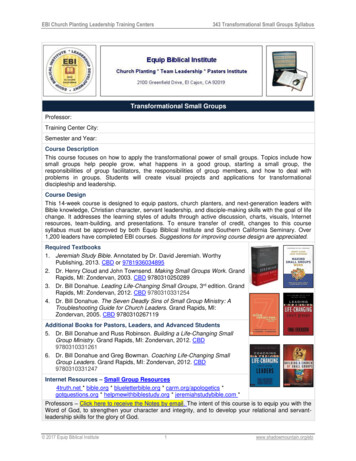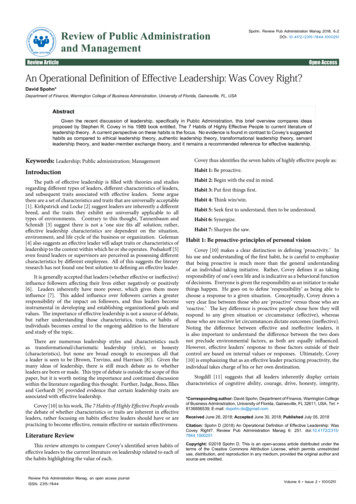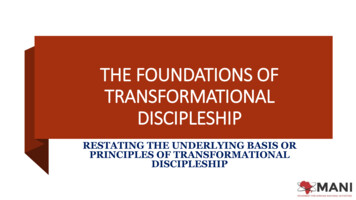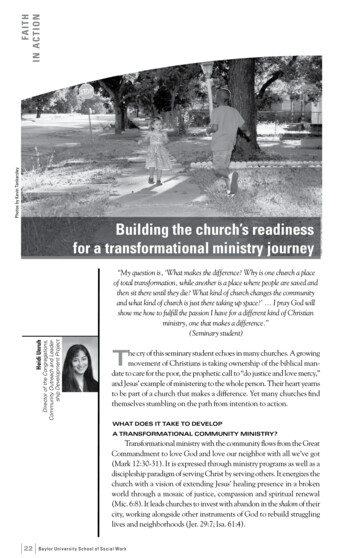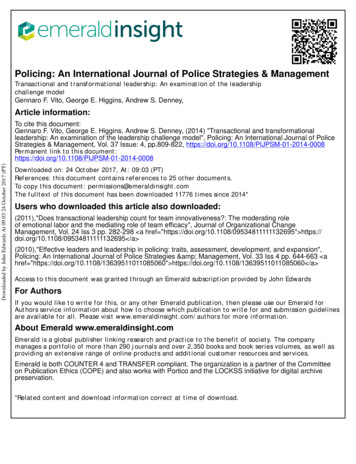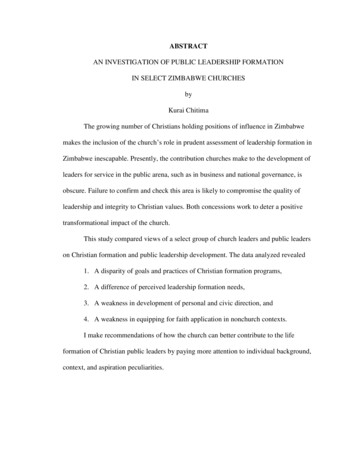
Transcription
ABSTRACTAN INVESTIGATION OF PUBLIC LEADERSHIP FORMATIONIN SELECT ZIMBABWE CHURCHESbyKurai ChitimaThe growing number of Christians holding positions of influence in Zimbabwemakes the inclusion of the church‘s role in prudent assessment of leadership formation inZimbabwe inescapable. Presently, the contribution churches make to the development ofleaders for service in the public arena, such as in business and national governance, isobscure. Failure to confirm and check this area is likely to compromise the quality ofleadership and integrity to Christian values. Both concessions work to deter a positivetransformational impact of the church.This study compared views of a select group of church leaders and public leaderson Christian formation and public leadership development. The data analyzed revealed1. A disparity of goals and practices of Christian formation programs,2. A difference of perceived leadership formation needs,3. A weakness in development of personal and civic direction, and4. A weakness in equipping for faith application in nonchurch contexts.I make recommendations of how the church can better contribute to the lifeformation of Christian public leaders by paying more attention to individual background,context, and aspiration peculiarities.
DISSERTATION APPROVALThis is to certify that the dissertation entitledAN INVESTIGATION OF PUBLIC LEADERSHIP FORMATIONIN SELECT ZIMBABWE CHURCHESpresented byKurai Chitimahas been accepted toward fulfillmentof the requirements for theDOCTOR OF MINISTRY degree atAsbury Theological SeminaryMay 4, 2010MentorDateMay 4, 2010Internal ReaderDateMay 4, 2010Representative, Doctor of Ministry ProgramDateMay 4, 2010Dean of the Beeson CenterDate
AN INVESTIGATION OF PUBLIC LEADERSHIP FORMATIONIN SELECT ZIMBABWE CHURCHESA DissertationPresented to the Faculty ofAsbury Theological SeminaryIn Partial FulfillmentOf the Requirements for the DegreeDoctor of MinistrybyKurai ChitimaMay 2010
2010Kurai ChitimaALL RIGHTS RESERVED
TABLE OF CONTENTSPageLIST OF TABLES . viiLIST OF FIGURES . viiiACKNOWLEDGEMENTS . ixCHAPTER 1 PROBLEM .1Introduction .1The Problem .1The Purpose .3Research Questions .4Research Question #1 .4Research Question #2 .4Definition of Terms.4Public Leader .5Christian Public Leader.7Leadership Development .8Christian Formation .13Context of the Study .16Africa Context .16Zimbabwe Context .20Methodology .24Participants .24Instrumentation .25iii
Variables .25Data Collection .25Data Analysis .27Delimitations and Generalizability .27Theological Foundation .27Overview of the Study .30CHAPTER 2 LITERATURE .31Introduction .31Theological Underpinning .32Nature of the Church .32Mission of the Church .35Missions and Culture .40Convergence of Missions Views .41Christian Formation Practices .49Mandate of Christian Formation .49Rationale of Intentional Christian Formation .51Christian Formation Principles from Christ‘s Ministry .56Christian Formation Phases .58Leadership Challenge in Africa .64Challenge of Development .65Challenge of Localization .67Challenge of Institutions and Systems .69Challenge of Christian Formation .70iv
Challenge of Theological Relevance .73Methodological Support.77CHAPTER 3 METHODOLOGY .80Problem and Purpose .80Research Questions .80Research Question #1 .81Research Question #2 .81Population and Participants.82Design of the Study.86Instrumentation .87Pilot Test .89Variables .90Reliability and Validity .91Data Collection .91Data Analysis .93Ethical Procedures .93CHAPTER 4 FINDINGS .95Problem and Purpose .95Participants .95Research Question #1 .96Research Question #2 .99Christian Formation Processes .99Leaders‘ Christian Formation Attitudes.104v
Public Leader Ongoing Support Needs.118Alternative Leadership Development Influences.119Summary of Major Findings .119CHAPTER 5 DISCUSSION .121Major Findings .121Finding One: Mismatch of Goals and Practices .122Finding Two: Mismatch of Perceived Needs.123Finding Three: Personal and Civic Direction .124Finding Four: Contextual Capacity.128Implications of the Study .131Limitations and Strengths .134Recommendations .135Suggestions for Further Studies .142Personal Reflections.143APPENDIXESA. Instruments .145B. Development Needs Mentioned .154C. Participants .159D. Biblical Interpretation in Methodological Pluralism .161WORKS CITED .163WORKS CONSULTED .172vi
LIST OF TABLESTable 3.1. The Public Leader Sampling Procedure .85Table 3.2. Objectives and Research Methods Used .87Table 4.1. Public Leadership Development Needs .97Table 4.2. Christian Mission Attitudes .105Table 4.3. Personal Vision Attitudes .106Table 4.4. National Vision Attitudes .107Table 4.5. Public Leadership Vision .108Table 4.6. Moral Values Attitudes .109Table 4.7. Handling Success and Failure Attitudes .110Table 4.8. Ethical Issues Attitudes .110Table 4.9. Family Attitudes .111Table 4.10. Personal Accountability Attitudes .112Table 4.11. Leadership Principles and Skills Attitudes .113Table 4.12. Handling Succession Attitudes .114Table 4.13. Faith Application Attitudes .115Table 4.14. Career Peculiarities Attitudes .116Table 4.15. Outside Church Relational Skills Attitudes .117Table 4.16. Distribution of Attitude Scores .118Table 4.17. Attitude Comparison Summary .120vii
LIST OF FIGURESFigure 2.1. Subject areas from the research title .31Figure 2.2. Comparing and contrasting addition to multiplicationin Christian formation .52Figure 2.3. The main Christian formation phases evident in literature .58Figure 3.1. Denominations and local church structure in Zimbabwe .83Figure 3.2. Data collection flow .92Figure 4.1. General public leader-church leader attitude to meeting needs.98Figure 4.2. Polygons of attitude score distributions .118Figure 5.1. Process integrity .123Figure 5.2. Relational priority.125Figure 5.3. Christian formation process .137Figure 5.4. Life cross-sectional dimensions .141viii
ACKNOWLEDGEMENTSA study of this magnitude is impossible without the participation of many people.I extend gratitude to my wife and children for their understanding and encouragement.The public and church leaders who participated in the research were indispensable. Dr.Tapiwa Mucherera was a most resourceful supervisor who offered invaluable support.Dr. Milton Lowe and Dr. Rick Gray played significant support roles, as members of thehearing committee, to make this project a success. May God reward them richly,including those I did not mention at Asbury, church, and family. Be it all to the glory ofHis name.ix
Chitima 1CHAPTER 1PROBLEMIntroductionThis study focused on understanding the public leadership developmentcontribution of local churches in an African context such as Zimbabwe. In 2000, thedirector of a nongovernmental organization who was a good person but did not attendchurch came to my office and said, ―Every leadership meeting I attend has these Jesuspeople. They seem to be everywhere. Tell me what is happening.‖ She had observed aphenomenon that is hard to ignore in Zimbabwe. Increasing numbers of church membersare occupying influential leadership positions in society.The ProblemThis study addresses the need to understand the role of the local church in theformation of high ranking Christian secular leaders, such as for the public arena thatincludes nonprofit, corporate, and political spheres. The research concentrates on publicleaders who are followers of Jesus Christ and members of local churches, serving insecular settings. Understanding how the church is contributing to the development ofsuch leaders in Zimbabwe is vague and the question of best practices for carrying out thisrole is unanswered. Developing leaders for church work receives considerable attention,even though this attention is not enough as observed by Victor Cole when he notes thatone of the critical issues facing the church in Africa today is a dearth of leadership (33).As a result, one hears calls to raise more leaders for the church. The skewed church view,however, is of placing much emphasis on training leaders for the church andconcentrating little on intentionally developing leaders for the secular arena. This bias, of
Chitima 2paying less attention to the development of market place (secular) leaders, is hard tojustify. One could argue that if the church does not develop leaders for itself no one elsewill. The same can however be said of the development of Christian secular leaders. Ifthe church does not deliberately raise good Christian secular leaders, no one else will.The church is responsible for raising Christian leaders not just for church work but alsofor the diverse areas of society. Both tasks fall within the ambit of the church‘s uniqueresponsibility. The church is the seedbed for mobilizing and nurturing lay people likeChristian secular leaders to be salt and light through functional lifestyles and work ethicsthat make a difference in the world of their vocations.The need to bring clarity to this subject is most compelling in places likeZimbabwe, Africa where churches are growing rapidly in a context of deepening socialchallenges. Societal aspirations for economic betterment and social peace have often beenelusive. During his life on earth, Jesus diagnosed a need for laborers when he saw howthe multitude was helpless, harassed, and without care and direction (Matt. 9:38). Thechurch is presently a community that can raise laborers who provide answers andguidance like good shepherds. Leaders are such laborers. John C. Maxwell notes thateverything rises and falls on leadership (49). Craig Van Gelder states this fact in anotherway when he says that ―nothing is more important than leadership‖ (17). Good leadershipis the answer to all societal challenges.Whether leaders are intentionally developed or not, leadership is bound to happen.Intentional leadership development provides the only opportunity to shape what theleadership will be. Everything else depends on how this responsibility is carried out(Maxwell 49; Barna 17). Developing able leaders is most needed in the postmodern era in
Chitima 3which the task of leading involves dealing with complex and dynamic socioeconomicenvironments. In response to this need, literature on leadership development isproliferating. The church must have better understanding of its role in developing andinfluencing leaders in today‘s world, and intentionally make its contribution to this mostcrucial task in the most comprehensive and effective manner.The PurposeThe purpose of this project was to explore the current local church Christianformation practices and perspectives as compared to the leadership development needs ofChristian public leaders currently serving in the areas of politics, business, andphilanthropy in the capital city of Harare, Zimbabwe. More elaborately, the purpose wasto explore ways to strengthen local church based development of public leadership bydoing a gap analysis, using both quantitative and qualitative approaches, between thecurrent situation and the desirable, as perceived by local church leaders and publicleaders. The inclusion of key leadership formation elements such as vision, character,relationships, competence, and contextualization in current Christian formation of publicleaders in select churches of Zimbabwe are examined, paying particular attention toChristian formation goals, content, and processes.The dissertation addresses the leadership development aspect of public leaders‘Christian formation. The study idea emanated from realizing an apparent lack ofunderstanding of how local churches are shaping the formation of character andcompetence of the growing number of Christians in public roles outside the church. Theabsence of clarity of how local church Christian formation is affecting public leadershipdevelopment is a deficiency that cannot be ignored in a country where economic
Chitima 4hardships and political strife accelerated between 2000 and 2009. The country is facingso many serious crises that all efforts to strengthen and train courageous and effectiveleadership should be galvanized. Also of critical importance is having an effectivetestimony of Christ‘s transforming love in every sector of society. The study comes froman assumption that the better a Christian leader is prepared for public leadership at churchthe better is their transformational effect in the community.Research QuestionsThis study answered the following questions in order to understand the leadershipformation elements included in the Christian formation processes of selected localchurches:Research Question #1What are the leadership development needs of Christian public leaders currentlyserving in the areas of politics, business, and philanthropy in the capital city of Harare,Zimbabwe?Research Question #2What are the current Christian formation practices and perspectives of the localchurches attended by the Christian public leaders currently serving in the areas ofpolitics, business, and philanthropy in the capital city of Harare, Zimbabwe?Definition of TermsMarket place/secular, in this study, is the literal or virtual place in a communitywhere people are formulating and trading services, commodities, and ideas outside thechurch setting. Church setting refers to the realm of work initiatives by the church withdirect benefit to the church. This term includes any service program in the church and run
Chitima 5through the church structures such as pastoral work, worship music, ushering at meetings,and other service roles whether part-time or full-time, voluntary, or paid for by thechurch.The research also used the following terms and definitions.Public LeaderPublic leader refers to someone who has entered the public arena where his/herleadership responsibility, visibility, and influence go far beyond his or her immediateorganization or sector, a concept that Michael D. Lindsay uses (1). This leader shouldhave a national vision for a progressive society with basic rights and means of life such asfood, shelter, work, literacy, health, and best possible education.The question of what good leadership is has been widely debated and a plethoraof literature on the subject is on the market. George Barna, after exploring variousdefinitions reaches the conclusion that leaders are people who have willing followers(22). Garry Wills concurs when he says that leadership is mobilizing others towards agoal shared by the leader and followers (14-15). Wills further cautions promotingleadership in a way that raises suspicion that being a follower is demeaning. Followers donot just exist to respond and fit the leader‘s plan, but to share in the plan. They are mostessential to a leader. Persons can have determination and focus, but without followers,they are not leaders (14-15). James G. Clawson gives a definition that includes the aspectof willingness on the part of the follower as well as the leader. He defines leadership asthe ability and willingness to influence others so that they respond voluntarily. Clawson‘sprimary argument is that voluntary acquiescence is impossible unless leadership
Chitima 6influence is for change at the level of a target person‘s values, assumptions, beliefs, andexpectations (44).Before leadership was as topical as it has become, J. Oswald Sanders definedleadership as ―the ability of one person to influence others to follow his or her lead‖ (27).Maxwell built on this concept in saying that ―Leadership is influence. That‘s it. Nothingmore, nothing less‖ (1). James C. Hunter also highlights the aspect of influence bydefining leadership as ―the skills of influencing [emphasis mine] people toenthusiastically work towards goals identified as being for the common good withcharacter [emphasis mine] that inspires confidence‖ (32). To Bobb Biehl, leadership is―knowing what to do next, why that is important, and how to bring appropriate resourcesto bear on the need at hand‖ (157). Lee Roy Beach makes change an obvious aspect ofleadership when he defines leadership as ―the art of producing appropriate changes in anorganization‘s environment, its functions and structure, its culture, and practices inpursuit of survival and prosperity‖ (ix). Clawson argues that effective leadership dependson seeing what needs to be done, understanding the underlying forces in the situation, andhaving the courage to initiate action to make things better (4). He adds that the key tobecoming an effective leader is being able to see what needs to change in oneself beforechanging others or the situation.Richard L. Hughes, Robert C. Ginnet, and Gordon J. Curphy posit that peoplewho research leadership disagree about what leadership really is. They reach theconclusion that one correct definition for leadership, for every person in every situationdoes not exist (6). Stephen Robbins notes, ―The leadership literature is voluminous, andmuch of it is confusing and contradictory‖ (366). The many definitions reflect the
Chitima 7different perspectives of leadership. A legitimate leadership depends on the willingnessof both the leader and the follower. If no one follows, leadership has not taken place. Inshort, leadership is the ability to influence and guide others to accomplish shared goalseven if they are challenging.Christian Public LeaderChristian public leaders refer to public leaders who are followers of Christ, areactive local church members, and who serve in secular settings. Christian leadership isdistinguished from leadership in general by the biblical values that underpin it. TheChristian leader views leadership as a ministry or act of service for God to humanity.A Christian leader can work in the church or in a secular vocation. Biehl definesChristian leadership as ―knowing what God wants to be done next, knowing why hewants it to be done, and knowing how to bring to bear the resources God would bring tobear on the need at hand‖ (157). J. Robert Clinton says Christian leaders ought to strive tobe Bible centered leaders who use God‘s word with impact and thus have ministries thatwill last (17). Barna defines such a leader as ―someone who is called by God to lead;leads with and through Christ-like Character; and demonstrates the functionalcompetencies that permit effective leadership to take place‖ (25). Spiritual leadershipdistinguishes itself in that, ―[t]he Spiritual leader influences others not by the power ofhis own personality but by that personality initiated and interpreted and empowered bythe Holy Spirit‖ (Sanders 20). The International Leadership Institute (ILI) NationalConference handbook defines spiritual leadership as ―the blending of the natural andspiritual qualities of a person in the service of God and for His glory‖ (ILI 33). Suchleadership begins with a call, is God enabled, and reflects the character of God.
Chitima 8Henry and Richard Blackaby hold the view that spiritual leaders understand thatGod is their leader (20-21). Spiritual leadership flows out of intimacy with God. ―Trueintimacy with God occurs through intentional effort over a long period of time as yourrelationship grows deeper‖ (ILI 4). Jim Cymbala exhorts that humility is to admit theneed for God and show it by seeking him fervently (19). Room is made for God‘s powerand glory in acknowledging human weakness (Jer. 29:13).Spiritual leadership distinguishes leaders who seek to lead God‘s way. Suchleadership is essential in the market place as in the churches (Blackaby and Blackaby 17).Christian leaders are defined, first and foremost, by who they are as followers of Christ—their identity, character, values, and purpose—before where they are located vocationally.Leadership DevelopmentLeadership development is a lifelong process of recognizing and harnessingleadership potential that depends on the leader‘s response to various God given personaland circumstantial influences in life (Clinton 40, 54). Clinton suggests a lifelongleadership formation model that involves the leader‘s choices and contextual factors overwhich he has no choice. He attributes the making of a leader to God who usesinstruments such as circumstances, people, and events over a lifetime from birth to death.Clinton identifies phases in the life of a leader and development priorities for each phase(25). He is of the view that achievement and finishing well is the ultimate test of goodleadership. Hughes, Ginnet, and Curphy give a closely related definition when they notethat leadership is developed through a variety of ways in a protracted process of action,observation, and reflection, comprising their AOR model (47). The sociocultural contextconditions the process.
Chitima 9The foremost challenge any entity (e.g., family, organization, church) faces is todevelop adequately, place appropriately, and appraise leaders objectively. Unde
transformational impact of the church. This study compared views of a select group of church leaders and public leaders on Christian formation and public leadership development. The data analyzed revealed 1. A disparity of goals and practices of Christian formation programs, 2.
